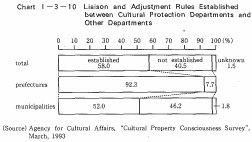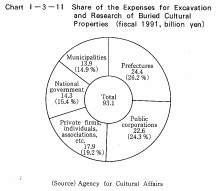| Home > Policy > White Paper, Notice, Announcement > White Paper > JAPANESE GOVERNMENT POLICIES IN EDUCATION, SCIENCE AND CULTURE 1993 > CHAPTER 3 �3 5 (2) | ||
When land development is planned on archaeological and/or historical subsoil, it is usually the case that a prior consultation be held between the respective prefectural or municipal board of education and the land developer, during which they adjust their courses of action in accordance with the site's degree of importance, and reach an agreement according to the following possibilities: (1) that the site containing the subsoil not be included in the development project area, (2) that the site, although kept in the project area, be preserved by partial amendments to the development plan and (3) that the site be investigated by excavation and documented in records. The number of cases of excavation and research that accompanied land development projects amounted to 8.200 cases in 1991.In order to harmonize the protection of cultural properties and land development undertakings, it is desirable that liaison and adjustment rules be established between cultural protection departments and other prefectural ormunicipal departments. According to the "Cultural Property Consciousness Survey", such liaison and adjustment rules have been established in more than 90% of prefectures and in more than 50% of municipalities (Chart I-3-10). It is necessary to see that this type of cooperation continues to increase.

Concerning the expenses for excavation and research that accompany land development, in principle, cooperation in this regard is requested of the enterpriser of the project which prompted the necessity for the excavation and research. If it is inappropriate to request that the enterpriser bear the cost of the investigation, such as in the case of archaeological subsoil being discovered during the construction of a private dwelling, as a rule the respective local government does the investigation subsidized by the national government. The breakdown of paid expenses for excavation and research in 1991 is shown in Chart I-3-11.
For the sake of smooth coordination with land development and with other undertakings, the Agency for Cultural Affairs has made previous arrangements with the central government's relevant ministries and agencies, and with public corporations which carry out large-scale development project to have comprehensive consultations about archaeological and/ or historical subsoil. It has also offered guidance to local governments in this area. The 1985 Report from the Provisional Council for the Promotion of Administrative Reform pointed out the acceleration of investigations of buried cultural properties. In response to this, the Agency for Cultural Affairs sent a circular entitled "Local Government Policies for the Acceleration of the Preservation and Investigation of Buried Cultural Properties" to local governments.
While means of accelerating the desk work related to buried cultural properties, for example, reporting, coordination and instruction are being explored, ways of promoting the acceleration of excavation and research are being sought in such forms as an increase in the member of local government personnel in charge of buried cultural properties, the establishment of excavation and research corporations and other means.

| Back to Top | MEXT HOME |